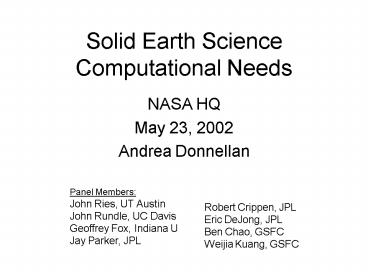Solid Earth Science Computational Needs - PowerPoint PPT Presentation
1 / 9
Title:
Solid Earth Science Computational Needs
Description:
... and how does the earth's surface respond? ... Create a Solid Earth Research Virtual Observatory (SERVO) ... Solid earth research virtual observatory (SERVO) ... – PowerPoint PPT presentation
Number of Views:51
Avg rating:3.0/5.0
Title: Solid Earth Science Computational Needs
1
Solid Earth ScienceComputational Needs
- NASA HQ
- May 23, 2002
- Andrea Donnellan
2
Solid Earth Science Questions
- What is the nature of deformation at plate
boundaries and the implications for earthquake
hazards? - How is the land surface changing and producing
natural hazards? - What are the interactions among ice masses,
oceans, and the solid earth and their
implications for sea level change? - How do magmatic systems evolve and under what
conditions do volcanoes erupt? - What are the dynamics of the mantle and crust and
how does the earths surface respond? - What are the dynamics of the earths magnetic
field and its interactions with the earth system?
3
The Solid Earth isComplex, Nonlinear, and
Self-Organizing
- Computational technologies can help answer these
questions - How can the study of strongly correlated solid
earth systems be enabled by space-based data
sets? - What can numerical simulations reveal about the
physical processes that characterize these
systems? - How do interactions in these systems lead to
space-time correlations and patterns? - What are the important feedback loops that
mode-lock the system behavior? - How do processes on a multiplicity of different
scales interact to produce the emergent
structures that are observed? - Do the strong correlations allow the capability
to forecast the system behavior in any sense?
4
Processes Take Place on Many Space and Time Scales
5
Recommendations
- Create a Solid Earth Research Virtual Observatory
(SERVO) - Numerous distributed heterogeneous real-time
datasets - Seamless access to large distributed volumes of
data - Data handling and archiving part of framework
- Tools for visualization, datamining, pattern
recognition, and data fusion - Develop an Solid Earth Science Problem Solving
Environment (PSE) - Addresses the NASA specific challenges of
multiscale modeling - Model and algorithm development and testing,
visualization, and data assimilation - Scalable to workstations or supercomputer
depending on size of problem - Numerical libraries existing within a compatible
framework - Improve the Computational Environment
- PetaFLOP computers with Terabytes of RAM
- Distributed and cluster computers for
decomposable problems - Development of GRID technologies
6
Solid Earth Research Virtual Observatory (SERVO)
Observations
Archive
- 1 PB per year data rate in 2010
- Distributed Heterogeneous Real-Time Datasets
TBytes/day
Archive
Downlink
Downlink
Tier 0 1
HPSS
Archive
Downlink
100 TeraFLOPs sustained
Tier 1
Tier 2
Fully functional problem solving environment
Tier 3
- Program-to-program communication in milliseconds
- Approximately 100 model codes
Institute
Institute
Institute
Institute
100 - 1000 Mbits/sec
Data cache
Tier 4
Workstations, other portals
- Plug and play composing of parallel programs from
algorithmic modules - On-demand downloads of 100 GB in 5 minutes
- 106 volume elements rendering in real-time
7
Virtual Observatory Project
- Solid earth research virtual observatory (SERVO)
- On-demand downloads of 100 GB files from 40 TB
datasets within 5 minutes. - Uniform access to 1000 archive sites with volumes
from 1 TB to 1 PB
Scaled to 100 sites
Prototype cooperative federated data base service
integrating 5 datasets of 10 TB each
Prototype modeling service capable of integrating
5 modules
Capability
Decomposition into services with requirements
Prototype 1920x1080 pixels at 120 frames per
second visualization service
Prototype data analysis service
Architecture technology approach
2003 2004 2005 2006 2007 2008 2009 2010
Timeline
8
Problem Solving Environment Project
- Fully functional PSE used to develop models for
building blocks for simulations. - Program-to-program communication in milliseconds
using staging, streaming, and advanced cache
replication - Integrated with SERVO
- Plug and play composing of parallel programs from
algorithmic modules
Integrated visualization service with volumetric
rendering
- Extend PSE to Include
- 20 users collaboratory with shared windows
- Seamless access to high-performance computers
linking remote processes over Gb data channels.
Capability
Plug and play composing of sequential programs
from algorithmic modules
Prototype PSE front end (portal) integrating 10
local and remote services
Isolated platform dependent code fragments
2003 2004 2005 2006 2007 2008 2009 2010
Timeline
9
Computational Environment
100 model codes with parallel scaled efficiency
of 50 104 PetaFLOPs throughput per subfield
per year 100 TeraFLOPs sustained capability per
model 106 volume elements rendering in real time
Capability
Access to mixture of platforms low cost clusters
(20-100) to supercomputers with massive memory
and thousands of processors
100s GigaFLOPs 40 GB RAM 1 Gb/s network bandwidth
2003 2004 2005 2006 2007 2008 2009 2010
Timeline































